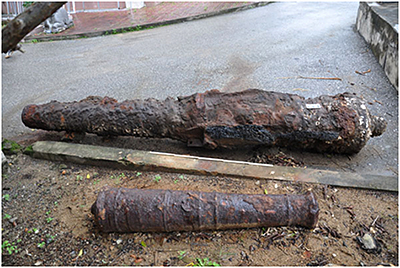
Cannon 1 (top) and cannon 2 (bottom) at the Nghe An province museum (photo by Mark Staniforth, courtesy of the Bach Dang River and Van Don Research Team)
The 2012 Field Season
Two cannon from the shipwreck are currently located outside in the backyard area of the Nghe An province museum. These cannon were inspected, documented and photographed on Monday 3 Dec 2012 and appear to date from the late eighteenth century.
Cannon 1
A large (3.7 m long) smooth-bore, muzzle-loading cast iron cannon with 10 cm (4 inch) bore diameter, two trunnions and a
cascabel together with the partial remains of the carriage. The cannon lies upside down with the upper surface on the ground,
which was unable to be inspected as the cannon was too large to turn over.
Assessment: This cannon is believed to be a cast iron "long nine" pounder (or demi-culverin style) cannon with a 4 inch (10 cm) bore firing a 9 pound (4 kg) solid spherical cast-iron shot fired by 4.5 pounds (2 kg) of black powder or gunpowder. This cannon probably dates to the late eighteenth century and may be an example of a "long-nine" which is a particular type of naval 9 pounder cannon designed with a longer barrel to increase the gun’s range. Condition is poor as it has a lot of concretion and active rusting caused by being separated from the gun carriage in the last few months.
Cannon 2
A medium (1.38 m long) smooth-bore, muzzle-loading cast iron cannon with a 7.5 cm (3 inch) bore diameter. The trunnions and
cascabel have been broken off and there is no trace of the carriage. The cannon was able to be rolled over to inspect all
sides.
Assessment: This cannon is believed to be a cast iron four pounder (or minion-style) cannon with a 3 inch (7.5 cm) bore firing a 4 pound (1.5 kg) solid spherical cast-iron shot fired by 2 pounds (1 kg) of black powder. This cannon probably dates to the late eighteenth or early nineteenth century. Condition is reasonable as it has very little concretion on but has several parts broken off (cascabel and both trunnions).

Carriage from Cannon 1 (photo by Mark Staniforth, courtesy of the Bach Dang River and Van Don Research Team)
Carriage From Cannon 1
The port "cheek" (or left side) of the wooden cannon carriage from Cannon 1 was inspected at the house of Mr Nguyen Van Binh
and has now been relocated to the Nghe An province museum. The carriage was 1.56 m in length, 0.375 m high and 0.08 to 0.09 m in
thickness. The remains of the iron axles for the two wheels are present and they indicate that the carriage had two different
sized wheels (the larger wheel at the front).
Assessment
The gun carriage is in good condition with no obvious teredo damage but has dried out since being raised and shows signs of
surface cracking. It has iron staining on the surface of the timber and a small part of the remains of the two cross-timbers
that once held this left "cheek" to the right side of the carriage (which has largely been destroyed by teredo damage). This,
with the description of the site by the finder, suggests that there is the potential for significant remains to be present.
One possibility for the identity of the Ngeh An shipwreck was a warship sunk as a result of an attack on Nghe An during the Tay Son uprising, probably in about June 1786, by Nguyen Hue, and a prominent Trinh defector Nguyen Huu Chinh, with a fleet of 400 ships. The attack on Nghe An was part of the successful Tay Son invasion of Dang Ngoai (Tonkin or northern Vietnam) and the vessel may be a Trinh vessel (later Le Dynasty).
This is a potentially interesting shipwreck site that we hope to conduct further research on in the future.
Next
